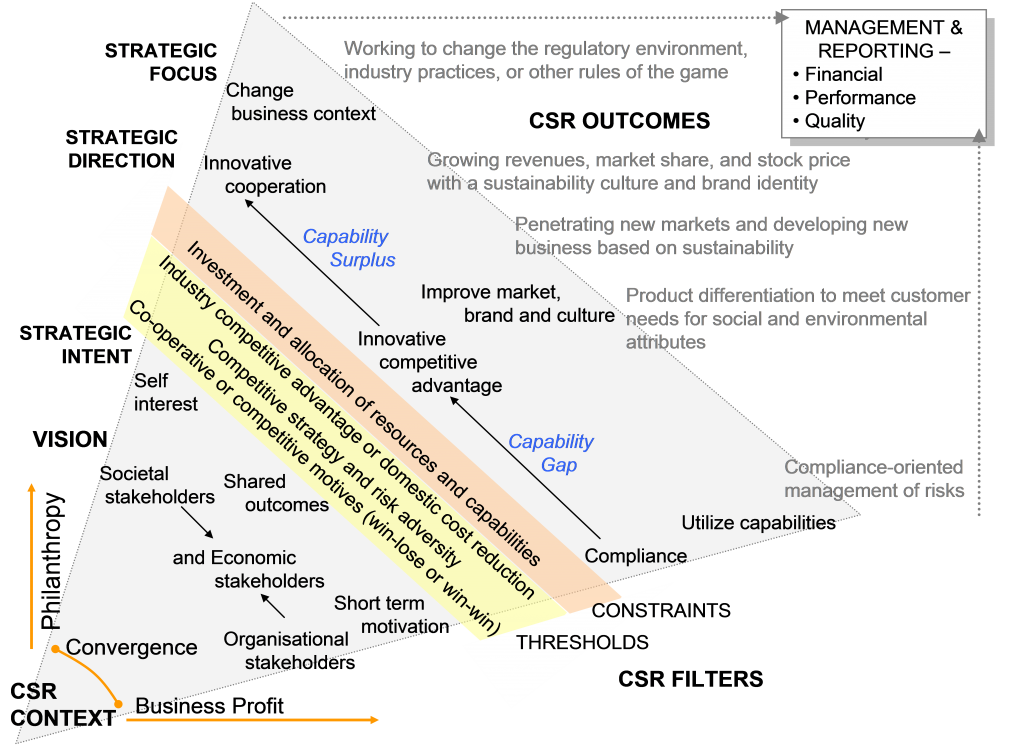2.4 Literature Review Summary
The literature review has, after an introduction to CSR context, discussed the different academic views of CSR strategy. This summary is to highlight previous research relevant to the research objectives in 1.1.2 and to develop a conceptual framework that assists in refining field research questions (figure 16).
WHY CSR?
Linking stakeholders to corporations’ vision and mission is regarded as the contemporary right way of defining business purpose, with the exception of pure philanthropy and pure business purposes. Securing all stakeholders are addressed and satisfied is described to be the route to CSR success.
Influence of leadership is heavily discussed, and is considered to be either the sole driver or the reason for not adopting a stakeholder satisfaction attitude. Short-term goals, self interest, lack of imagination or innovative capabilities, misunderstanding, low change tolerance and difference in assessment of situation have been determined to be some of the likely influencing factors.
When reading the literature you could perhaps expect to find more description of how to build a business case for CSR. Laszlo (2005) are the only source linking investments, costs and benefits that are usable in a business case context.
Benefits of CSR towards all stakeholders are well documented by case stories and empirical evidence.
One major benefit within business strategy context is the long-term view of CSR. Linking business strategy to the trends in society is perhaps the most important issue.
This convergence of interest continuously increases the CSR threshold levels, also within the environmental areas, and creates threats and opportunities for business managers.
The ability to foresee the future, build scenarios and promote appropriate business cases are some of the key competences needed to create sustainable strategies.
WHY NOT CSR?
Organisational and environmental constraints have been discussed and the importance of shared investment, resource allocation and the human resource capabilities highlighted.
Studies have shown that there is no evidence of linking CSR to an increase in share price. The positive outcomes of CSR range from risk management to changing the rules of the game. It seems that these outcomes are competitive strategy based, and the relevance of measuring CSR success on share price compared to other strategy decisions could have been discussed more in literature.
CSR threshold levels are discussed and seen as either drivers or constraints. Differences in place in the value network, internationalisation and corporations’ competitive strategy are determined to influence the CSR strategy adaptation.
Cultural and ethical differences create a challenge in the decision process due to filters in the mental sensemaking process, and achieving a shared purpose culture (for both positive and negative outcomes) is seen as the foundation in any CSR cooperation.
The reasons for not adopting CSR in corporation’s strategy may be due to personal or organisational cultural resistance, or lack of capabilities in creating stakeholder satisfaction.
WHAT CSR DIRECTION?
CSR strategies (as illustrated in figure 16) are determined to be either:
Structural compliance to regulations, with the main focus to utilize existing capabilities. This strategy may be due to or create a gap in capabilities that need to be developed to improve innovative capabilities.
Strategic innovative competitive advantage, with the main focus to improve brand, market and culture. This strategy may create surpluses of capabilities that potentially can be utilized in corporative clusters.
Strategic innovative cooperation, with the main focus to change the business context. This strategy is based on value network clusters where risk, cost and benefits are shared between the parties.
Figure 16: Framework of Literature Review Reference

Source: Author’s own creation, based on frameworks and models in literature review
HOW, WHEN and WHERE TO IMPLEMENT CSR
To overcome the constraints and align the filters in the sense making process and to secure change and sustainable achievement of CSR outcomes a tool kit and eight critical disciplines in the implementation have been discussed.
The importance in anticipation of the future stakeholder reactions, setting sustainable values and goals, designing and selection of initiatives that support the CSR strategy, development of a business case and linkage to follow-up in business quality, performance and financial management is discussed, and seems to be important to achieve and sustain the desired outcomes, behaviours and value.






